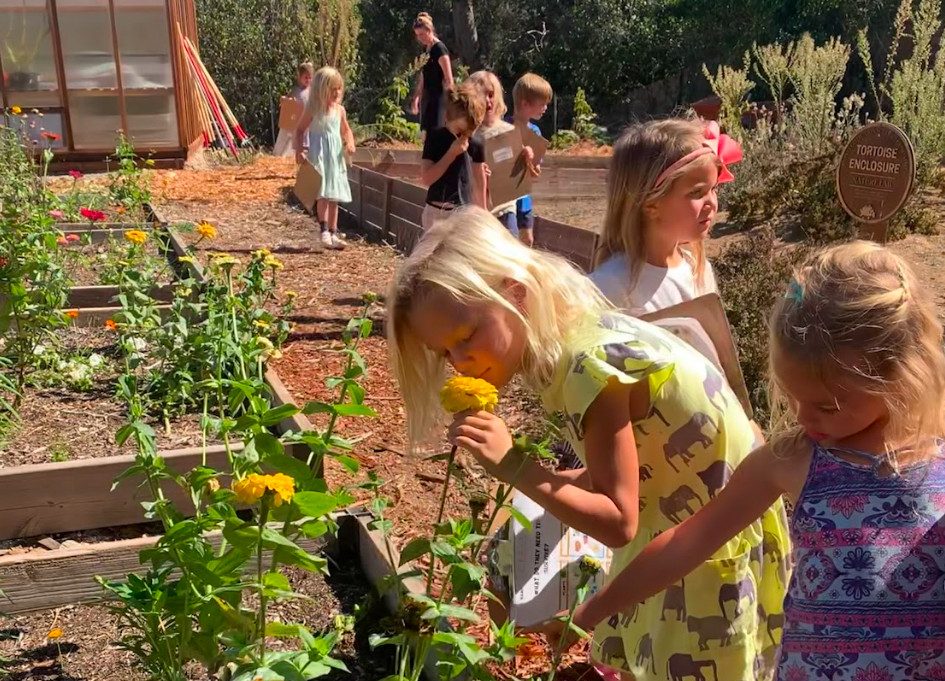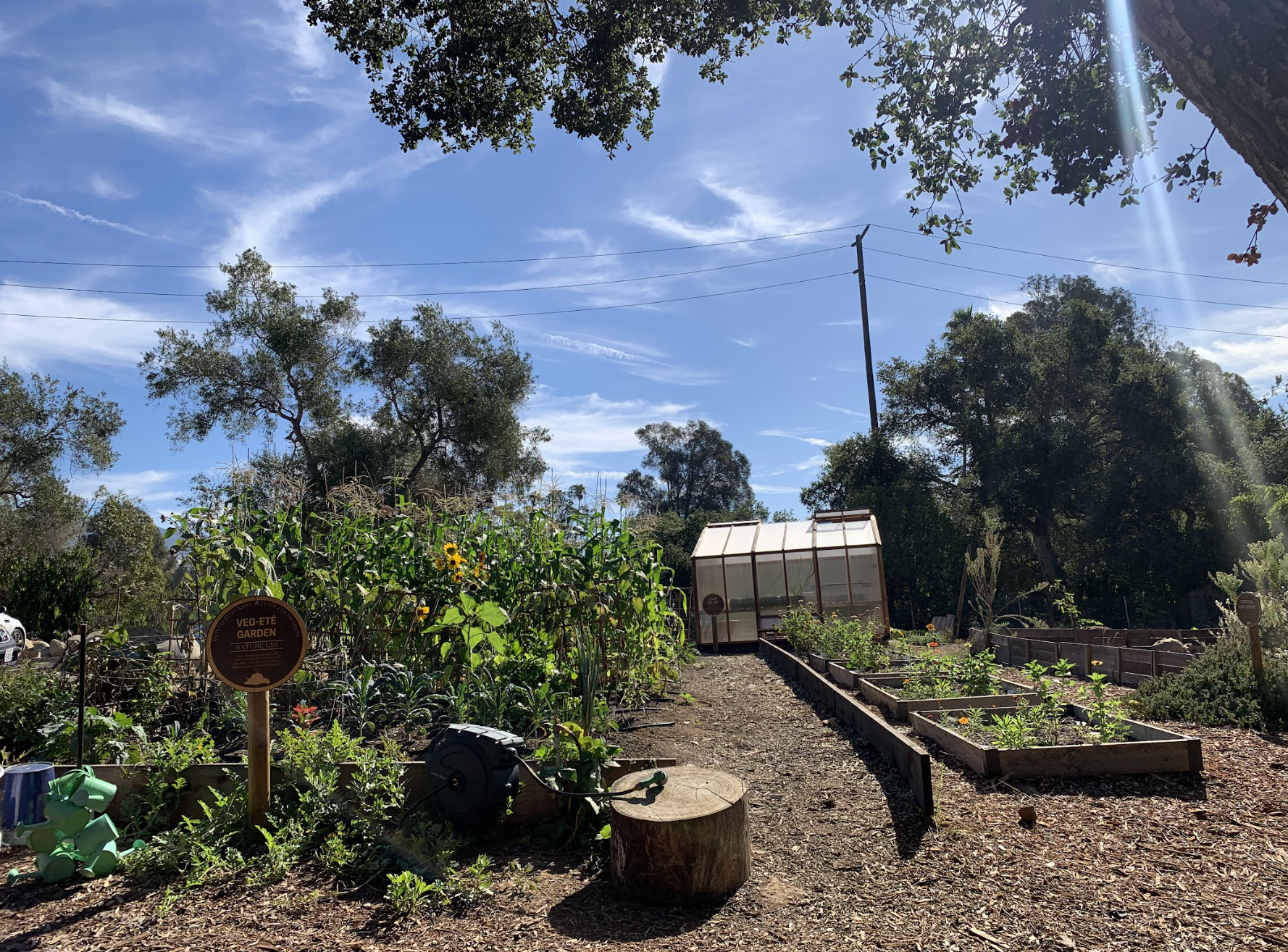Connecting Kids and Community Through Soil
A Tour Through Montecito Union School’s Lush Nature Lab

At the base of the Santa Ynez mountains, on Montecito’s San Ysidro Road, a very ambitious and beneficial thing is happening. Microbes are thriving, goats are grazing, and children are climbing. Welcome to Nature Lab.
Located immediately south of Montecito Union School, Nature Lab is a three-acre parcel that has been slowly converted from a compacted dirt lot with a condemned house to a thriving landscape of native plants with grazing animals and hands-on learning spaces. Something has grown from nothing.
On the day I visited in October, armfuls of marigolds were being harvested for a school celebration of Día de los Muertos by Nature Lab’s bright and energetic naturalist, Sammy Simon. Laden with flowers, Simon explained, “The Spanish teacher requested them; I’m going to put them all over the school.”
The marigolds were grown in Nature Lab’s in-ground garden (meaning, planted directly in the ground), which features a rotating crop of edibles and seasonal flowers. “This is the third year of our in-ground garden,” explained Anthony Ranii, Montecito Union’s superintendent. That timeline matters, because it takes time and patience to transform dirt into soil, and soil is required to bring life back to the land.
Simon and her team have built Nature Lab’s soil using strictly organic and regenerative practices with the help of students, volunteers, and local businesses. “Our first approach to regenerating the soil at Nature Lab was to recycle as many nutrients as possible from our organic waste on campus,” Simon explained. “We trained students on how to sort their waste at lunch in order to source an abundance of nitrogen-rich material for our compost system,” Simon continued. The team then incorporated the compost into the Nature Lab’s soil to “improve microbial activity, soil structure, and water retention capability,” Simon explained.

Mulching has also been essential in building Nature Lab’s soil. “Mulching transformed this dusty site that was hard to dig in, into spongy soil that is softer, healthier, and much easier to plant,” explained landscape architect and Montecito Union parent Brook Eiler. Like a fallen tree that slowly breaks down in the forest, mulch — typically wood chips — layered on top of soil slowly breaks down and becomes part of the soil. “This took a lot of truckloads of wood chips!” explained Ranii. “Nature Lab established an early relationship with tree companies to drop off free wood chips,” explained Eiler. Volunteers, including parents and teens from AHA!, can be regularly seen spreading donated wood chips at Nature Lab. Building soil is a dynamic, ongoing process.
Soil needs water to grow plants, so smart water management has been a big focus at Nature Lab. “The goal used to be to get water off the land as quickly as possible,” explained Eiler. “Now we try to get the water into the land as quickly as possible.” She continued, “We do this by capturing and slowing down as much rainwater as possible, with berms, wood chips, and compost.” Healthy soil, planted with natives adapted to our climate, helps with water retention; Nature Lab is home to more than 300 native shrubs and trees. It is also home to goats and chickens. The goats and chickens “turn weeds and extra food scraps into valuable manure and fresh eggs,” Simon explained.
Montecito Union students spend time in Nature Lab every week; being there inherently teaches the children about water use, how food is grown, and how animals interact with the land. Plants are grown in-ground — in that healthy soil we just explored — and hydroponically. “The hydroponic towers show kids a different way to grow food,” explained Ranii. “They require one-twentieth of the water used in in-ground gardens, which matters as our earth warms.” Additionally, fruit trees dot the property and passionfruit vines climb arbors. The food grown at Nature Lab is distributed according to a one-third policy. One third is integrated into school lunches; one third is sold via CSA boxes that 5th-grade students sell back to the community to raise money for their annual colonial trip; one third is donated to local nonprofits, including Storytellers Preschool.

But Nature Lab isn’t all about food. The land features a sensory garden for students with heightened sensory needs; a tree house; a large-scale building-block area, including wooden boards and heavy climbing ropes; and an outdoor amphitheater for performances. “Those rocks are not meant to be moved,” joked Ranii of the carefully placed rocks around the amphitheater. He then gestured to the “big play” area where kids are welcome to move their bodies and objects to their heart’s content, a child’s expertise. Aesthetics come into play at Nature Lab too. Its large solar array over the outdoor learning pavilion is tilted ever so slightly to frame Montecito Peak; a green wall provides privacy from the neighbor’s property; a Japanese-style bridge arches up and over a stream.
So, how did all this happen?
Montecito Union first acquired the Nature Lab property in 2007 as part of a land swap with the Montecito YMCA. The YMCA swapped the Nature Lab parcel for what is now their member parking lot on Santa Rosa Lane. For years, the parcel sat vacant, un-affectionately called “the adjacent property.” In 2017, Ranii joined the team and was given a tour of the property. When asked for ideas on what to do with the land, Ranii recalls immediately saying, “Well if it were me, I’d put plants and animals here.” And then, chuckling, he noted, “Wait, it is me!”
Montecito Union then undertook an exhaustive evaluation process to determine the best use of the land, polling parents and students and hiring a consultancy to guide them through the most beneficial options for the school and community. Ultimately, the community unanimously agreed to develop an outdoor learning space. The nature-based plan for the land fit the school’s culture of environmental stewardship and positive change-making, and all classroom space needs were met, so it was a go. Ranii’s vision came to play; today, Nature Lab is full of plants and animals.

The development of Nature Lab has relied on a healthy mix of professional services, grants, and deep expertise found in our community. Experts such as Eiler and the team at the Santa Barbara Botanic Gardens have generously contributed their knowledge and professionalism to the project. “Santa Barbara has incredible people,” explained Carolyn Fitzgerald, MUS Foundation Board Vice President. “We have been very fortunate to harness talent found in our community to do really great work,” explained Fitzgerald.
With our changing climate, talking to kids about how we treat the earth has become both imperative and personal. Kids get it, and they want and need outlets for taking action. We also know that connecting with nature is healthy and meaningful for kids. Nature Lab provides opportunities for kids to both connect with and support nature. “We are at the intersection of STEAM and the natural world,” explained Fitzgerald. Such hands-on learning yields sticky memories.
“Now that we’ve built this, we have a responsibility to share it,” explained Ranii. In a push to share, Nature Lab recently partnered with United Way to host 30 students for a day of outdoor experiential learning. Part of United Way’s Fun in the Sun Program, the day was such a success that Nature Lab looks to partner with other large organizations like United Way to provide more opportunities for outdoor learning to children beyond our community. “We are elevating to a higher vision,” explained Fitzgerald. “We want to be a lighthouse of inspiration for other schools and communities,” she continued. “We want to share our work and toolkit,” she explained, so that other Nature Labs can sprout and flourish. It’s not just about Montecito Union anymore.
With World Soil Day on December 5, and on the back of two recent screenings of regenerative farming documentaries in Santa Barbara, Nature Lab’s work has never felt more relevant to our community. In Santa Barbara, “We are living at the intersection of nature and people; what can we do to leave the land better than when we found it?” posed Ranii. Nature Lab helps answer that question.



You must be logged in to post a comment.